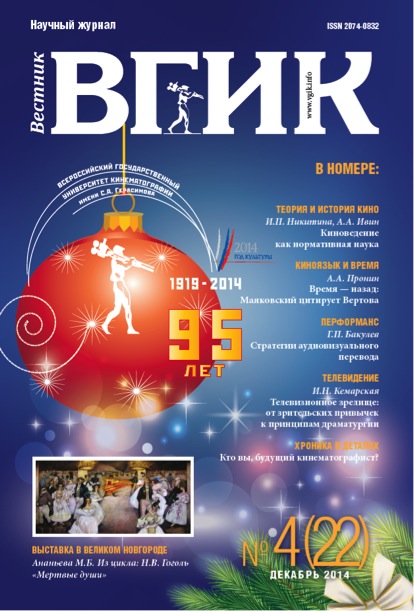Strategies of Audiovisual Translation
- 作者: Bakulev G.P.1
-
隶属关系:
- VGIK
- 期: 卷 6, 编号 4 (2014)
- 页面: 48-60
- 栏目: PERFORMANCE | ART OF PRESENTATION
- URL: https://journals.eco-vector.com/2074-0832/article/view/14805
- DOI: https://doi.org/10.17816/VGIK6448-60
- ID: 14805
如何引用文章
全文:
详细
The issue of audiovisual translation (AVT) seems particularly important in contemporary cinema. As argued, translation is delivered between cultures rather than words. The text is seen as an integral part of the world, but not as its separate fragment. Therefore the translation process is regarded as a crosscultural transfer, defined by the level of the prestige of a source and target cultures, as well as their relationships. The article discusses two main strategies of translation in cinema - dubbing and subtitling, which differ in the degree of interference in the original text. On the one hand, dubbing modifies the original text to a greater degree, making it more comprehensible for the audience. Whereas subtitling, i.e. presenting the dialogue in the target language in the form of synchronous subtitles, makes the least changes in the source text. The choice of a translation strategy generally depends on the view of the target culture and is often influenced by the political factors. Dubbing and subtitling represent two extreme points on the translation range, defined by two opposite types of cultural systems - domestication and foreignization. To suppress or to accept the “foreign” nature of imported films is the key to how a country regards itself in relation to the others and how it realizes the importance of its own culture and language. Fast changes characteristic of our time exert a considerable impact on audiovisual translation. One of the consequences of globalization-localization process is growing diversification of audiovisual production. Scientific and technological progress forms the basis to develop new methods of AVT and means of its realization. Such tendencies testify to huge potential capabilities of amelioration of the translation quality and specialization, providing more universal access to mass media for all social categories thereby accelerating their social integration into modern society.
作者简介
Gennady Bakulev
VGIK
编辑信件的主要联系方式.
Email: editor@vestnik-vgik.com
PhD in Philology, Professor (Russian and Foreign Languages Department)
参考
- Козуляев А.В. Аудиовизуальный полисемантический перевод как особая форма переводческой деятельности. Обучение данному виду перевода // URL.: http://www.russian-translators.ru/about/editorial/audiovizualnyperevod / (дата обращения: 01.11.2014).
- Danan Martine (1991) "Dubbing as an Expression of Nationalism" Meta, XXXVI4, Munday, Jeremy (2001) Introducing Translation Studies. Theories and Applications. London and New York: Routledge.
- Diaz Cintas, Jorge and Anderman, Gunilla. Introduction // Audiovisual Translation Language Transfer on Screen / Edited by Jorge Diaz Cintas And Gunilla Anderman. Palgrave Macmillan, 2005.
- Hatim Basil and Ian Mason (1997) The Translator as Communicator. London: Routledge. Ascheid, Antje (1997) "Speaking Tongues: Voice Dubbing in the Cinema of Cultural Ventriloquism". In The Velvet Light Trap, no. 40.
- Venuti Lawrence (1995). The Translator's Invisibility. A History of Translation, London and New York: Routledge.
补充文件







